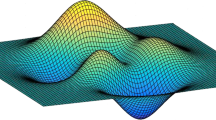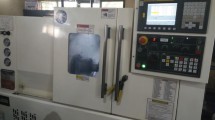Abstract
This paper presents an application of the Taguchi parameter design method to optimizing the surface finish in a turning operation. The Taguchi parameter design method is an efficient experimental method in which a response variable can be optimized, given various control and noise factors, and using fewer experimental runs than a factorial design. The control parameters for this operation included: spindle speed, feed rate, depth of cut, and tool nose radius. Noise factors included varying room temperature, as well as the use of more than one insert of the same specification, which introduced tool dimension variability. A total of 36 experimental runs were conducted using an orthogonal array, and the ideal combination of control factor levels was determined for the optimal surface roughness and signal-to-noise ratio. A confirmation run was used to verify the results, which indicated that this method was both efficient and effective in determining the best turning parameters for the optimal surface roughness.
Similar content being viewed by others
References
Yang WH, Tarng YS (1998) Design optimization of cutting parameters for turning operations based on the Taguchi method. J Mater Process Technol 84:122–129
Cesarone J (2001) The power of Taguchi. IIE Solutions 33(11):36–40
Roy RK(2001) Design of experiments using the Taguchi approach: 16 steps to product and process improvement. Wiley, New York
Feng C-X, Wang X-F (2003) Surface roughness predictive modeling: neural networks versus regression. IIE Trans 35:11–27
Davim JP (2001) A note on the determination of optimal cutting conditions on the surface finish obtained in turning using design experiments. J Mater Process Technol 116(2/3):305–308
Kopac J, Bahor M, SokoviC M (2002) Optimal machining parameters for achieving the desired surface roughness in fine turning of cold pre-formed steel workpieces. Int J Mach Tools Manuf 42(6):707–716
Thomas M, Beauchamp Y, Youssef AY, Masounave J (1995) Effect of tool vibrations on surface roughness during lathe dry turning process. Comput Ind Eng 31(3/4):637–644
Schimmel RJ, Manjunathaiah J, Endres WJ (2000) Edge radius variability and force measurement considerations. ASME J Manuf Sci Eng 122:590–593
Huang Y, Liang SY (2003) Cutting forces modeling considering the effect of tool thermal property—application to CBN hard turning. Int J Mach Tools Manuf 43:307–315
Davim JP (2003) Design of optimisation of cutting parameters for turning metal matrix composites based on the orthogonal arrays. J Mater Process Technol 132:340–344
Vernon A, Özel T (2003) Factors affecting surface roughness in finish hard turning. In: Proceedings of the 17th International Conference on Production Research (ICPR-17), Blacksburg, Virginia, August 2003
Fowlkes WY, Creveling CM (1995) Engineering methods for robust product design: using Taguchi methods in technology and product development. Addison-Wesley, Reading, Massachusetts
Harig H (1978) Basic precision machining for metalworking trainees. National Tooling and Machining Association, Washington, DC
VNE Corporation (1999) Versa-Turn Catalog. Janesville, Wisconsin
National Weather Service (2003) Temperature, degree days, and precipitation normals in El Paso, Texas for June. National Weather Service Forecast Office, El Paso Area, Santa Teresa, New Mexico Available online at http://www.srh.noaa.gov/elp/climat/elpclimate/elpjunnorm.shtml
Avallone EA, Baumeister T III (eds) (1996) Marks’ standard handbook for mechanical engineers (10th edn). McGraw-Hill, New York
Babus’Haq RF, Probert D, Snaith B, O’Callaghan PW, George HE (1990) Perceived and real roughness variations across machined surfaces. Int J Mater Prod Technol 5(1):12–24
Author information
Authors and Affiliations
Corresponding author
Rights and permissions
About this article
Cite this article
Kirby, E.D., Zhang, Z., Chen, J.C. et al. Optimizing surface finish in a turning operation using the Taguchi parameter design method. Int J Adv Manuf Technol 30, 1021–1029 (2006). https://doi.org/10.1007/s00170-005-0156-0
Received:
Accepted:
Published:
Issue Date:
DOI: https://doi.org/10.1007/s00170-005-0156-0




